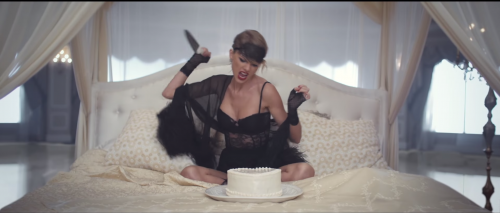
Image Credit:
Screenshot by Deb Streusand from https://www.youtube.com/watch?v=e-ORhEE9VVg, Taylor Swift's video for "Blank Space"
In my Rhetoric of Performance class, we begin each class day by watching and discussing a brief performance a student has brought in to share with the class. Since these performances are supposed to be 3-5 minutes, students frequently bring in music videos. With each performance, we do an informal rhetorical analysis.
First I ask the students what they noticed about the performance while they were watching. They frequently make note of things like symbolism and imagery – in other words, they tend to close read the videos. The goal of my line of questioning after that, however, is to bring them away from that tendency and into the world of rhetorical analysis.
I ask the students what they think the argument of the performance is. The argument of a performance is not like the argument of a written piece. With a good piece of persuasive writing, as a rule, everyone should come away from it with the same general idea of what the argument was. With a performance, it’s not a bad thing if we come away with some disagreement as to what the argument might be. The students often debate what the argument is, or bring in a multiplicity of answers, but they never have trouble finding some argument in the piece, even though music videos aren’t necessarily designed to make and defend a claim. One of the principles I put forth in teaching this class is that every performance has an argument. I believe this is true, but making the claim makes me a little nervous, because defending it is inevitably inductive – I will never conclusively prove that every single performance has an argument. However, each class day, my students add credence to my gradual inductive proof of this claim, because they have never failed to find an argument in any performance we’ve watched.
After we’ve wrangled over the argument for a while, we start talking rhetorical appeals. They don’t know that’s what we’re doing yet, though. We haven’t actually entered the rhetorical analysis unit. But we’ve been doing this all semester, from the second class day. By the time they get to rhetorical analysis, they’re already going to be pros at doing it – all that will be new to them is the terminology.
Every day, I ask them: what kind of persona does the performer present in making this argument? What is the intended audience, and how are they supposed to feel? How is the argument supported? What are the current social conversations to which this argument is contributing? Ethos, pathos, logos, kairos – all in a 4 minute video. My students practice rhetorical analysis 10-15 minutes per class day, all semester long. And because music videos are fun to watch and take apart, they have a great time while they’re doing it.
We don’t always watch music videos. Some students bring in short dance pieces, or political rants, or slam poetry. I mention music videos because they would be easy to incorporate into a non-performance rhetoric class as a warmup for rhetorical analysis. To make it simpler, the professor might choose them instead of having students bring them in, to make sure there’s lots to talk about – I always start the semester with Beyoncé’s video for “Flawless,” which has never failed to spark dialogue. The main point is to get the students used to doing rhetorical analysis while talking about something that’s fun.

